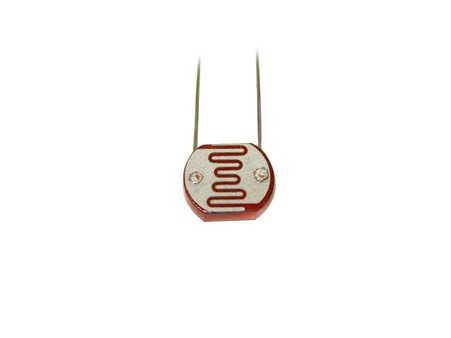1. 光敏电阻瓷的特性
光导材料加上电极之后,便构成光敏电阻,在研究光敏电阻配方和工艺时,必须先了解光敏电阻的特性。光敏电阻瓷有如下几方面的特性:
(1) 光谱特性
这是指光敏电阻灵敏度最高时所处的那段光波波长范围,如CdS灵敏度峰值在520nm, CdSe灵敏度峰值波长在720nm, 两者按不同比例形成固溶体时,灵敏度峰值范围在520~720nm 之间连续变化。
(2) 灵敏度
光电导灵敏度是指一定的光照条件下所产生的光电流的大小,与材料的光生载流子数目及电极之间的距离有关。在不同的应用场合表示方法不同。
光敏电阻无光照时的电阻值RD 称为暗电阻。光照后的电阻值Rp, 称为亮电阻。
因为亮电阻随光照强度改变,所以电阻灵敏度只有标明是什么光照强度的才有意义。
光敏电阻的暗电阻、亮电阻能简单明了地反映光敏电阻的灵敏度,所以也常用电阻参数表示光敏电阻的灵敏度。
(3) 照度特性
光敏电阻的照度特性是指它的输出信号(电压、电流或电阻值)随着光照度的改变而改变的特性。
(4)响应时间
光敏电阻的响应时间是在光照下亮电流达到稳定值所需的上升时间及遮光后亮电流消失所需要的衰减时间。通常把达到稳定电流的63. 2%需要的时间规定为上升时间,而把遮光后衰减掉原来稳定电流的63. 2%所需的时间规定为衰减时间。响应时间随照射光强不同而不同。响应时间与灵敏度是相互矛盾的两个参数,响应时间快则灵敏度低,灵敏度高时响应时间变长,故制造光敏电阻时要根据使用要求综合考虑。
(5)温度特性
光敏电阻的光导特性和电学特性受温度影响较大,关系较复杂。一般用温度系数αT描述光敏电阻的温度特性。

图.光敏电阻
2.其他光敏材料
(1)电子照相用感光材料的制备
电子照相用感光材料,要求颗粒细。因为微细的感光粉可使感光层均匀,同时颗粒间接触的面积增大,可防止过电流烧损光电装置。微细光电导粉末的制造方法很多,归纳起来有以下几种。一是把已有的光电导粉体进一步粉碎,使其结晶遭到破坏,降低光电导灵敏度;另一种是在光电导粉体制造过程中,少加熔剂或不加熔剂进行烧成,以使晶粒成长缓慢。制造光电导粉末过程中,烧成温度应比熔剂的熔点低,以防止晶粒过分长大。但这两种方法不能达到光电导粉体敏化的目的,不能得到光电导灵敏度高的感光材料。
还有一种方法是CdS粉末中加入适量的敏化剂和施主掺杂剂,再混合,在高温高压下,使CdS再结晶,可得到5μm以下粒径的高灵敏度的光电导微细粉体。但这种方法要求高温高压下的时间过长,因而缺乏实用性。比较好的方法是制造光电导粉体时,在配料中加入分散剂。在烧成中分散剂对粉体起隔离作用,可以获得细晶。
(2)彩色电视摄像管靶材的制备
光电导材料的一个重要应用是作彩色电视摄像管中的靶材,且已商品化。彩色电视摄像管中的靶材有Sb2S3、PbO、Si、CdSe等。
Sb2S3靶——光电灵敏度低,且使图像残留在荧光屏上的多。
PbO靶——制造工艺复杂,成本高,对红光灵敏度低。
Si靶——由于是单晶片,荧光屏的图像易生白斑,且因为使用了集成电路技术,形成了矩阵状p-n结,使图像的清晰度不好。
CdSe靶——光电导灵敏度高,暗电流小,稍有残余图像便暂留在荧光屏上。
一般彩色电视摄像管的靶,对蓝色的短波光灵敏度比绿色和红色的低。整个彩色电视摄像管对光的灵敏度由对蓝色的灵敏度来决定。因此作为彩色电视摄像管的靶子,要求对全部可见光灵敏,特别希望对蓝色光具有高灵敏度且对光的瞬态响应要快。
声明:本文由 CERADIR 先进陶瓷在线平台的入驻企业/个人提供或自网络获取,文章内容仅代表作者本人,不代表本网站及 CERADIR 立场,本站不对文章内容真实性、准确性等负责,尤其不对文中产品有关功能性、效果等提供担保。本站提醒读者,文章仅供学习参考,不构成任何投资及应用建议。如需转载,请联系原作者。如涉及作品内容、版权和其它问题,请与我们联系,我们将在第一时间处理!本站拥有对此声明的最终解释权。









